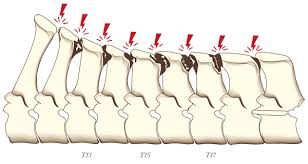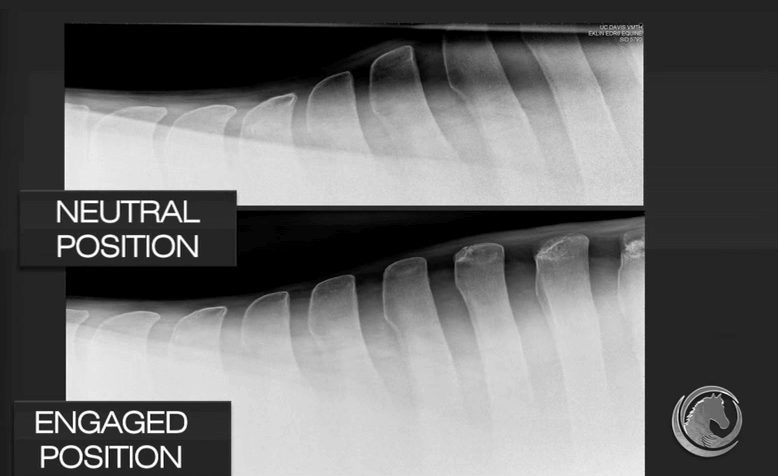Author Ella Attrill Dip Vet Phys IAAMT ESMT
Kissing spine is when the dorsal spinous processes are too close together and over-riding with each other which can create tension release on the interspinous ligament and causes a reaction in the bone to become fibrous which can result in loss of the ligament.
The specific cause of kissing spine in unknown but ridden horses of any age or stage of their career can develop the condition and one of the symptoms commonly associated with kissing spines is back pain, these factors are thought to be contributors to the condition but cannot be defined as the cause.
- Poor riding technique – Hollow backed, above the bit, or overbent etc.
- Poor fitting tack.
- Trauma – a bad fall or slip in the field.
- Concurrent lameness.
- Foot imbalance.
The clinical signs of kissing spines can be as follows;
“Signs include being cold backed, reluctance to jump or work in an outline, as well as an exaggerated response to stimulation or palpation of the back (a sore back). Alternatively, the reverse can occur, which is little or no movement in responses to back stimulation, if the horse is guarding the thoracolumbar spine from motion that results in pain. Some animals resent pressure to the sternum (breast bone) because this stimulates them to lift the back which may also be painful. Many horses show low grade bilateral hind limb lameness; more severe unilateral lameness is rarely observed. Horses with kissing spines often show a decrease in hind limb impulsion, which means they generate less power from the hindquarters. Some affected horses resist collection, some bolt, and some even show profound behavioural changes. These clinical signs are considered as quite unspecific as they can be present with many other musculoskeletal conditions.” (1. St.James Veterinary Group)
Treatment for kissing spine is dependent on the severity of the impingement and back pain associated. Some horses can be conservatively treated with non-surgical rehab as a starting point, firstly by making the horse comfortable by injecting corticosteroid into the area, this helps to temporarily make them more comfortable to enable exercises to be carried out to help build the correct musculature. By helping to engage the core and raise the back with exercises we can build strength in these areas with the aim of resolving the spinal crowding. Rehab plans should begin with in-hand pole work and progressing onto using lunging aids such as an Equi-Ami or Equi-Band which encourages the horse to propel from his hind end. After successful results from the in-hand work approximately 3-6 weeks on, riding exercises can commence but this varies completely on the horses progress.
Veterinarians Dr Joanna Robson, Dr Sarah le Jeune and Dr Sue Dyson conducted a study where they demonstrated how proper engagement of the horse’s core can help avoid painful back issues such as “Kissing Spine.” The study involved taking X-rays of the horse’s spine in a neutral position and then took another set of X-rays with the horse in an engaged position. They found that an engaged and rounded back increased the spaces between the vertebrae, thereby reducing the risk of the vertebrae rubbing together as opposed to a horse who is travelling with a hollow back.
Below is an example taken from the video of the X-rays which demonstrates this theory;
(2. Equitopia Center 2016)
If X-rays are taken and the horse already has impingement on the spinous processes the functional movement of the spine is reduced which can lead to compensatory issues in the SI joint, legs and neck which happens as a result of the kinetic chain being interrupted.
Surgical treatment options are the traditional surgery route which involves taking out some of the bone from the effected spinous processes. Rehabilitation for this surgery can be lengthy, with a recovery starting point of three months onwards. It can be costly and invasive, which could also result in very obvious scarring which may cause interference with a saddle in the future.
The other option is an Inter-spinous Ligament Desmotomy (ISLD) founded by Richard Coomer in 2009. The ISLD surgery involves making an incision along the spine and cutting the interspinous ligament where the dorsal spinous processes are making contact, which in turn removes the pain from the nerve endings which stick to the bone and the associated muscular spasms. Recovery of the ISLD is much faster (around six weeks) as it is less invasive to the horse and less risk of any surgical complications.
From a treatment point of view with both surgical options, physio treatment can commence just a few days post-surgery to deal with healing of wounds and the swelling associated with the trauma impacted on the muscles from surgery. Then following on from that we would be looking at the horse from a holistic point of view and treating any compensatory issues which may have occurred from the back pain and build a rehab plan to include exercises to encourage strengthening of the back and core during box rest, progressing to in-hand work, then eventually under saddle.
From a ridden aspect the rider should again be concentrating on building core strength with long and low work, lots of transitions, half-halts, pole work and hill work with an aim of maintaining flexion over the spine with the head just in front of the vertical until he is strong enough to build into any kind of collection work.
Prevention is better than a cure, so if we are starting off horses in their ridden careers by ensuring their bodies are strong enough to cope with a rider and their demands we will be minimising the risk of developing kissing spine or any other injury. Something as simple as incorporating a stretching routine into your day can be very beneficial to back health. Complete all the stretches every day initially, but for maintenance include it 4-5 times per week.
Here are my top 5 stretches:
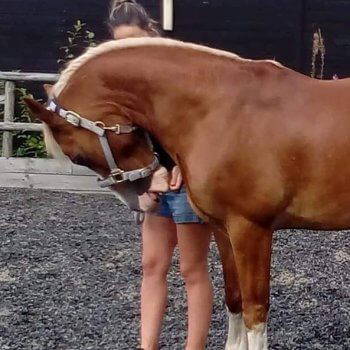 Chin to chest stretch – Standing at the horses shoulder, facing forward holding a carrot in front of the chest to encourage him to bring his chin toward his chest and hold this position for a 5-10 seconds.
Chin to chest stretch – Standing at the horses shoulder, facing forward holding a carrot in front of the chest to encourage him to bring his chin toward his chest and hold this position for a 5-10 seconds.
This encourages deep flexion of the mid-upper neck.
2.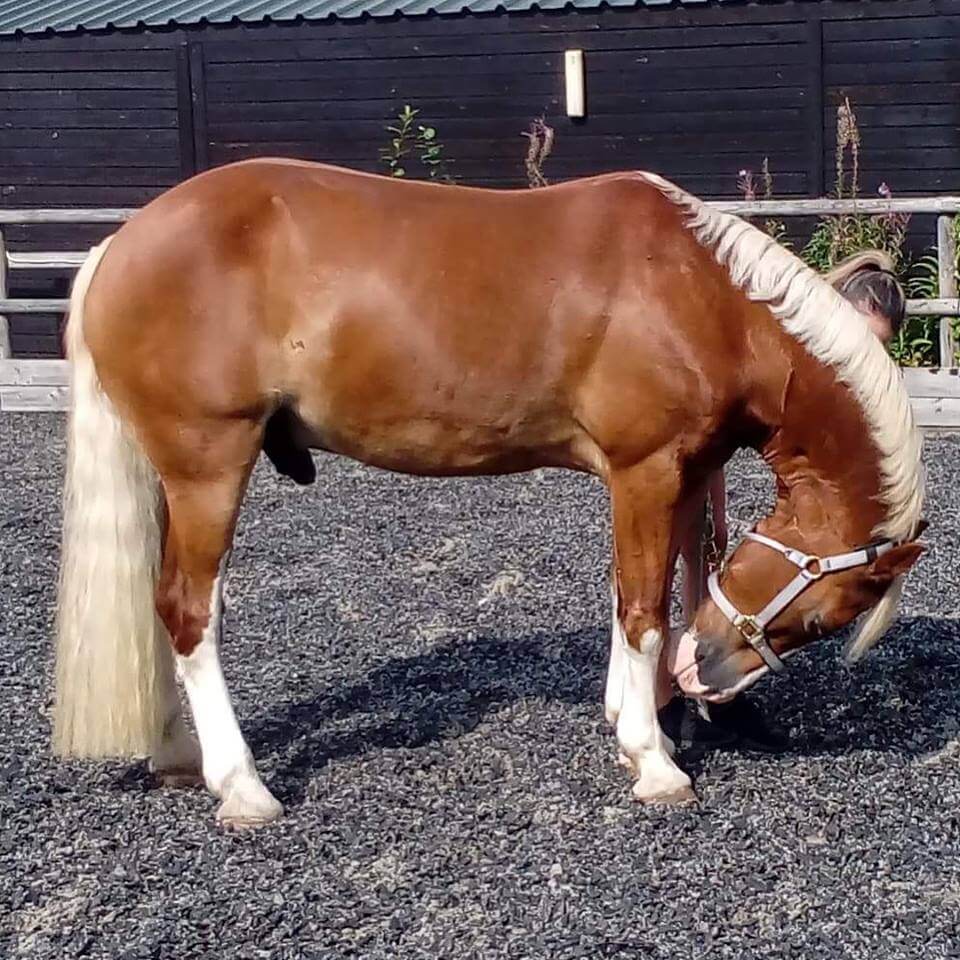 Chin to fetlock stretch – Facing forward and standing near the horses girth, pass the carrot between the fetlocks and encourage him to bring his head down between his legs, holding the position for 5-10 seconds. Making sure the horses head is straight and not bending to one side.
Chin to fetlock stretch – Facing forward and standing near the horses girth, pass the carrot between the fetlocks and encourage him to bring his head down between his legs, holding the position for 5-10 seconds. Making sure the horses head is straight and not bending to one side.
This exercise encourages deep flexion of the lower neck.
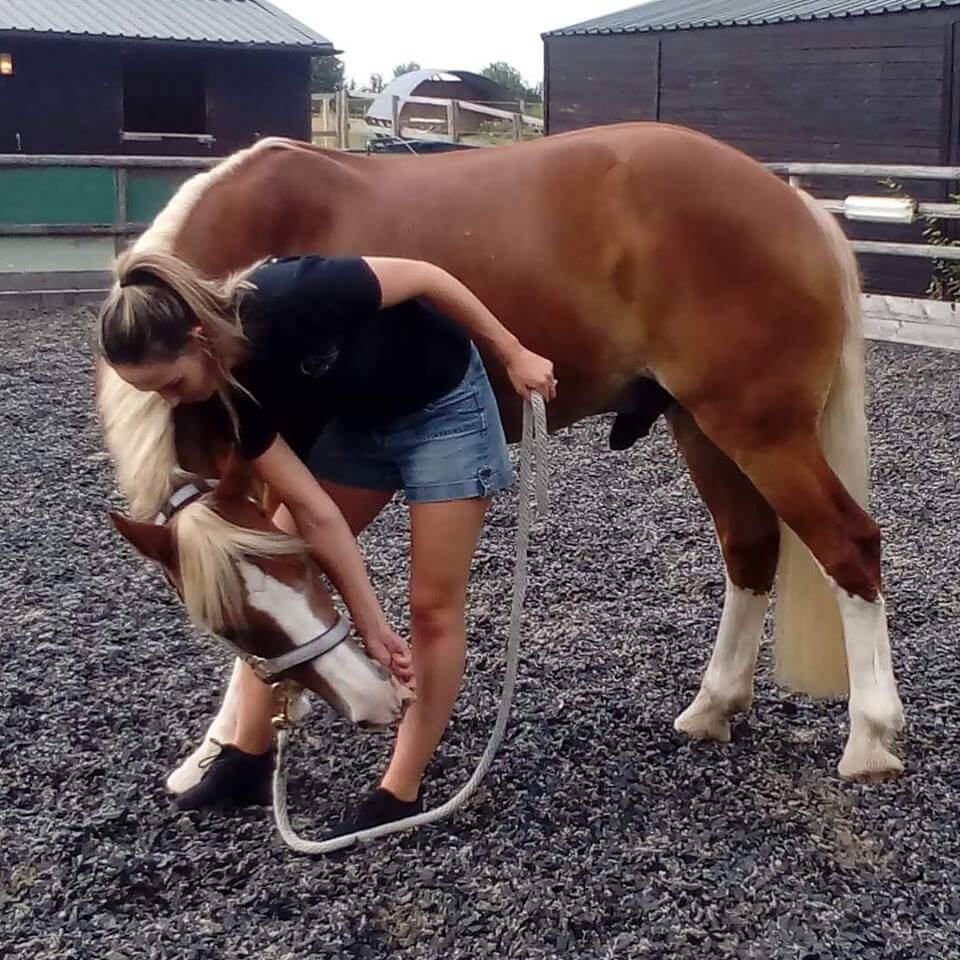 Chin to Hind Fetlock – Standing at the horses girth encourage the head down and round, towards the hind fetlock enticing his chin as far down and around as possible. Hold for 5 – 10 seconds.
Chin to Hind Fetlock – Standing at the horses girth encourage the head down and round, towards the hind fetlock enticing his chin as far down and around as possible. Hold for 5 – 10 seconds.
This stretch stimulates the lateral bending of the thoraco-lumbar spine and the neck as well as activating the abdominals and pelvic stabiliser muscles.
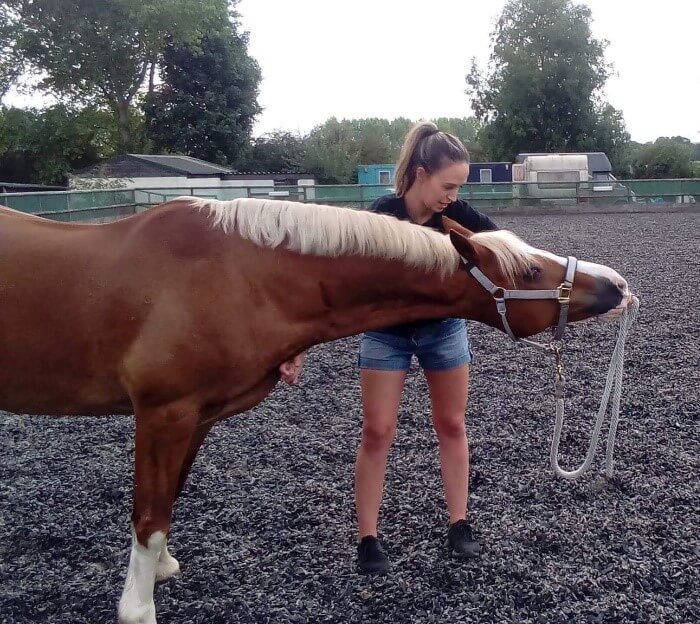 Carrot Reach Stretches – Standing facing the horse with the carrot in the hand nearest to the head, and the other hand placed on the chest to stop him moving forward, use the carrot to entice him to reach as far forward as possible. Keeping the head at the level of the chest to ensure correct back posture.
Carrot Reach Stretches – Standing facing the horse with the carrot in the hand nearest to the head, and the other hand placed on the chest to stop him moving forward, use the carrot to entice him to reach as far forward as possible. Keeping the head at the level of the chest to ensure correct back posture.
This stretch engages the thoracic sling and abdominals allowing the back muscles to relax and the spine and ribcage to lift.
 Lumbosacral Lift – This exercise is to be done with caution. Apply light pressure initially and perform it to the side of the horse until you are comfortable the horse does not display any signs of kicking.
Lumbosacral Lift – This exercise is to be done with caution. Apply light pressure initially and perform it to the side of the horse until you are comfortable the horse does not display any signs of kicking.
Stand behind the horse and run your thumbnails along the ‘poverty line’ from the top of the hind quarters back towards the tail until you find the ‘sweet spot’ in which the horse starts to round its haunches and lift the lumbar spine and pelvis. Hold for 5-10 seconds.
This exercise encourages the horse to lift the lumbar, lumbosacral (pelvic) joints, and stimulates the abdominal and back muscles. This exercise benefits greatly to those horses which struggle to engage their abdominals and allow their hind feet to come under them whilst working.
References
- http://www.stjamesvet.co.uk/pet-factsheets/Factsheets/Horse/24_295897.shtml
- http://equitopiacenter.com/developing-your-horses-back-the-biomechanics-of-engagement/
Search
Recent Articles
Categories
- Advice Hub
- Athlete
- Carriage Driving
- Dentistry
- Dressage
- Endurance
- Eventing
- Farrier
- Featured
- Featured Horse Ads
- Featured Posts
- Horse Racing
- Horse's Mouth
- Horseball
- Hunting
- Le Trec
- Leisure Riders
- Mounted Games
- Nutrition
- Polo
- Polocrosse
- Reining
- Rescue & Rehabilitation
- Show Jumping
- Showing
- Tack Room
- Team Chasing
- The Pony Club
- Therapy
- Training
- Vaulting
- Veterinary




